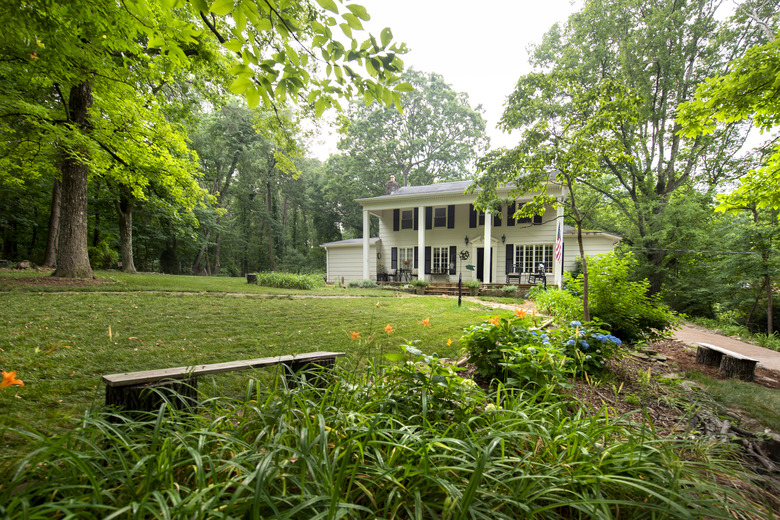A DIY Beginner's Guide To Yard Grading
We may receive a commission on purchases made from links.
One of the main purposes of yard grading is to make sure that water flows away from your home's foundation, but grading is also important for the health and appearance of your lawn and garden. According to Yardcare.com, the minimum slope away from the foundation should be 2 to 3 inches for every 10 feet, or about 2 percent, to prevent drainage problems. On the other end of the spectrum, the maximum slope should be 12 inches for every 4 feet, or about 25 percent, to prevent erosion.
It takes heavy equipment and an experienced contractor to grade your yard on a large scale, but fixing problem areas and making grade adjustments around the foundation is a DIY project for anyone who doesn't mind getting their hands dirty. Yard grading basically consists of moving dirt from one place to another using a flat shovel and wheelbarrow for larger loads and a landscaping rake for smaller ones. Before you do any digging, you have to measure the current grade and set your goal for the grade you want to achieve.
How to Measure the Existing Grade
How to Measure the Existing Grade
Since the grade is most important near the foundation of the house, that's the first place to check it, and you can do this with a pair of wooden stakes, some string, a line level and a tape measure. Pound one stake into the ground next to the foundation and the second about 8 feet away. Lawn Legion recommends separating the stakes by 100 inches because that makes it easier to calculate the slope.
Tie the string to the stake near the foundation and push it down to ground level. Stretch out the string so it is taut, and while holding it tightly, attach a line level to the string and center the level's bubble to level the string. Tie the string to the second stake. Measure the distance from the string to the ground next to the second stake. Divide this distance (in inches) by the distance between stakes (also in inches) and multiply by 100 to get the slope percentage.
For example, if the string extends 100 inches between stakes and the distance to the ground near the second stake is 1.5 inches, you would divide 1.5 by 100 for a result of 0.015, or 1.5 percent. If the percentage you calculate is below the minimum (as in the example), you have to adjust the grade by removing some dirt, and if it's above the maximum, you have to add dirt.
Measure the slope at several places around the foundation as well as along walkways and driveways because they too can be damaged by poor drainage. While you're at it, look for hills and depressions that need to be flattened. You'll be able to handle shallow ones with a landscaping rake, but low spots that are deeper than about 1 inch will probably require additional soil.
Yard Grading Without Heavy Machinery
Yard Grading Without Heavy Machinery
Once you've determined where the slope needs to change, it's time to get out the tools. Woodard recommends removing 8 inches of topsoil from around the foundation so you can get a fresh start on rebuilding the slope, but if the grade already has a downward slope (just not enough of one), you can probably repair the grade without all that labor. In any case, you will have to remove some topsoil so you can work on the compacted subsoil, and to make it easier to work, it's a good idea to till it with a power tiller.
Now that the subsoil is loose enough to work, shift the dirt around with a landscaping rake, increasing the slope by bringing extra dirt to the top and removing dirt from the bottom as needed. If the land slopes too steeply for this repair strategy to work, you may have to construct a retaining wall, French drain or some other drainage solution to prevent water damage in problem areas.
Leveling and Finishing
Leveling and Finishing
Once you've finished the regrading (and filling low spots and places where puddles form with extra soil), check the grade again using your stakes and leveled string. When everything checks out, replace the topsoil you removed to a depth of about 4 inches. Till it into the subsoil, smooth it out with a rake and then water well to compact the soil.
A final step recommended by most landscapers is to plant grass seed immediately because the roots help to bind the soil and prevent erosion. Water the grass frequently — one to several times a day — depending on the amount of sun it gets.

